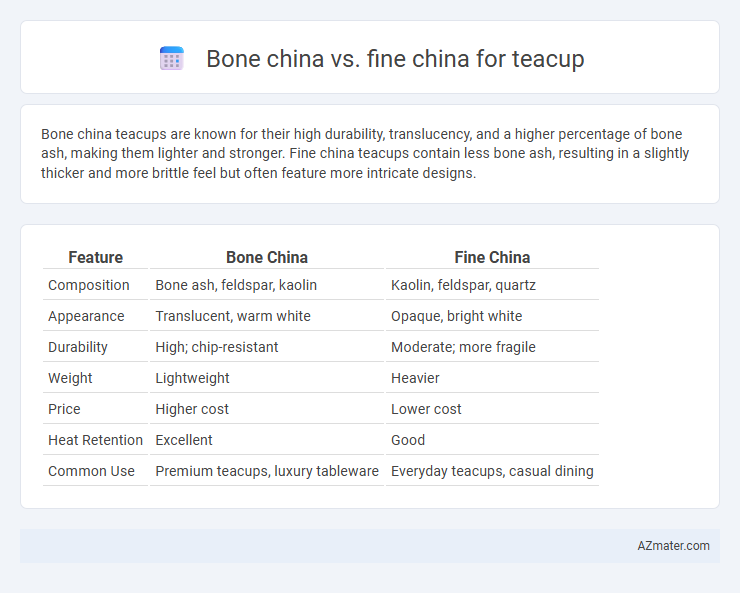Bone china teacups are known for their high durability, translucency, and a higher percentage of bone ash, making them lighter and stronger. Fine china teacups contain less bone ash, resulting in a slightly thicker and more brittle feel but often feature more intricate designs.
Table of Comparison
| Feature | Bone China | Fine China |
|---|---|---|
| Composition | Bone ash, feldspar, kaolin | Kaolin, feldspar, quartz |
| Appearance | Translucent, warm white | Opaque, bright white |
| Durability | High; chip-resistant | Moderate; more fragile |
| Weight | Lightweight | Heavier |
| Price | Higher cost | Lower cost |
| Heat Retention | Excellent | Good |
| Common Use | Premium teacups, luxury tableware | Everyday teacups, casual dining |
Understanding Bone China: Definition and History
Bone china, developed in 18th-century England, is a type of porcelain that incorporates bone ash, feldspathic material, and kaolin, resulting in a material prized for its whiteness, translucency, and strength. Fine china, often composed of kaolin and feldspar without bone ash, tends to be less translucent and more porous compared to bone china. The inclusion of bone ash in bone china enhances durability while maintaining a delicate appearance, making it a preferred choice for high-quality teacups.
What is Fine China? Key Characteristics
Fine china is a type of porcelain known for its high-quality craftsmanship and durability, made from kaolin clay and fired at high temperatures. It features a translucent body, smooth texture, and a glossy finish, often decorated with intricate patterns and gilding. Compared to bone china, fine china is typically less expensive and slightly less durable but remains a popular choice for elegant teacups and dinnerware.
Material Composition: Bone Ash vs Clay
Bone china teacups are crafted with a high percentage of bone ash, typically 25-50%, mixed with kaolin clay and feldspar, resulting in a translucent, durable, and lightweight porcelain. Fine china teacups primarily consist of kaolin clay with minimal or no bone ash, producing a denser and less translucent material that remains elegant yet less resilient than bone china. The distinct material compositions influence the teacup's strength, translucency, and overall quality, making bone china a preferred choice for premium, delicate teaware.
Comparing Appearance: Translucency and Color
Bone china teacups exhibit a unique translucency that allows light to pass through gently, creating a delicate and almost ethereal glow, attributed to their high bone ash content which thins the material without compromising strength. Fine china, often made from kaolin and feldspar, tends to be more opaque with a denser and whiter appearance, lacking the same degree of translucency found in bone china. The color of bone china typically leans toward a warm, creamy white, whereas fine china is usually a cooler, brighter white, impacting the visual warmth and elegance of teacup designs.
Durability and Strength: Which is Better?
Bone china offers superior durability and strength compared to fine china due to its higher content of bone ash, which enhances its resilience and chip resistance. Fine china, made primarily from kaolin and feldspar, is more prone to cracking and chipping under stress. For teacups requiring long-lasting use and greater toughness, bone china is the better choice.
Weight and Feel: Handling Differences
Bone china teacups are lighter and more delicate, offering a smooth, almost translucent feel due to their high calcium phosphate content from bone ash. Fine china teacups tend to be slightly heavier and sturdier, crafted from a mixture of clay, feldspar, and quartz, giving them a denser, more solid handling experience. The weight difference impacts comfort during use, with bone china preferred for its lightweight elegance and fine china valued for its robust durability.
Price Comparison: Cost of Bone China vs Fine China
Bone china teacups generally command higher prices than fine china due to their superior strength, translucency, and the complex manufacturing process involving bone ash. Fine china is often less expensive, as it lacks bone ash and features a slightly less durable composition, making it more accessible for everyday use. The price gap reflects bone china's premium quality and rarity, with teacups typically costing 20-40% more than comparable fine china pieces.
Suitability for Daily Use and Special Occasions
Bone china teacups offer superior durability and chip resistance, making them highly suitable for daily use, while also providing a delicate, translucent appearance ideal for special occasions. Fine china teacups, crafted from porcelain with a higher density, are more fragile and better reserved for elegant gatherings or formal events. The enhanced strength of bone china ensures long-term resilience without compromising the refined aesthetic desired in both casual and celebratory settings.
Care and Maintenance: Cleaning Your Teacups
Bone china teacups require gentle cleaning with mild detergent and warm water to preserve their translucency and delicate glaze, avoiding abrasive scrubbers that can cause scratches. Fine china teacups, typically more porous, benefit from hand washing to prevent chipping and retain their intricate patterns, while dishwasher use is generally discouraged. Proper drying with a soft cloth prevents water spots and maintains the teacup's pristine finish, ensuring long-lasting beauty and durability.
Which to Choose: Bone China or Fine China for Teacups?
Bone china teacups are known for their exceptional strength, translucency, and lightweight feel due to their high bone ash content, making them ideal for delicate, everyday use. Fine china teacups, made primarily from kaolin and feldspar, offer elegance and resistance to chipping but tend to be heavier and less translucent. When choosing between bone china and fine china teacups, prioritize bone china for durability and a refined aesthetic, while fine china suits those seeking traditional porcelain with a more substantial feel.

Infographic: Bone china vs Fine china for Teacup
 azmater.com
azmater.com